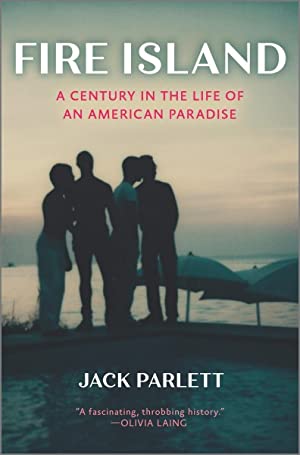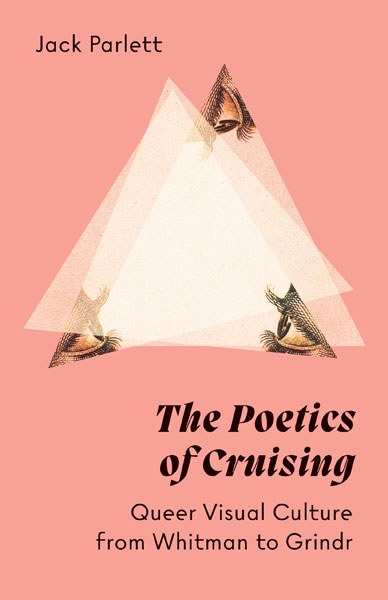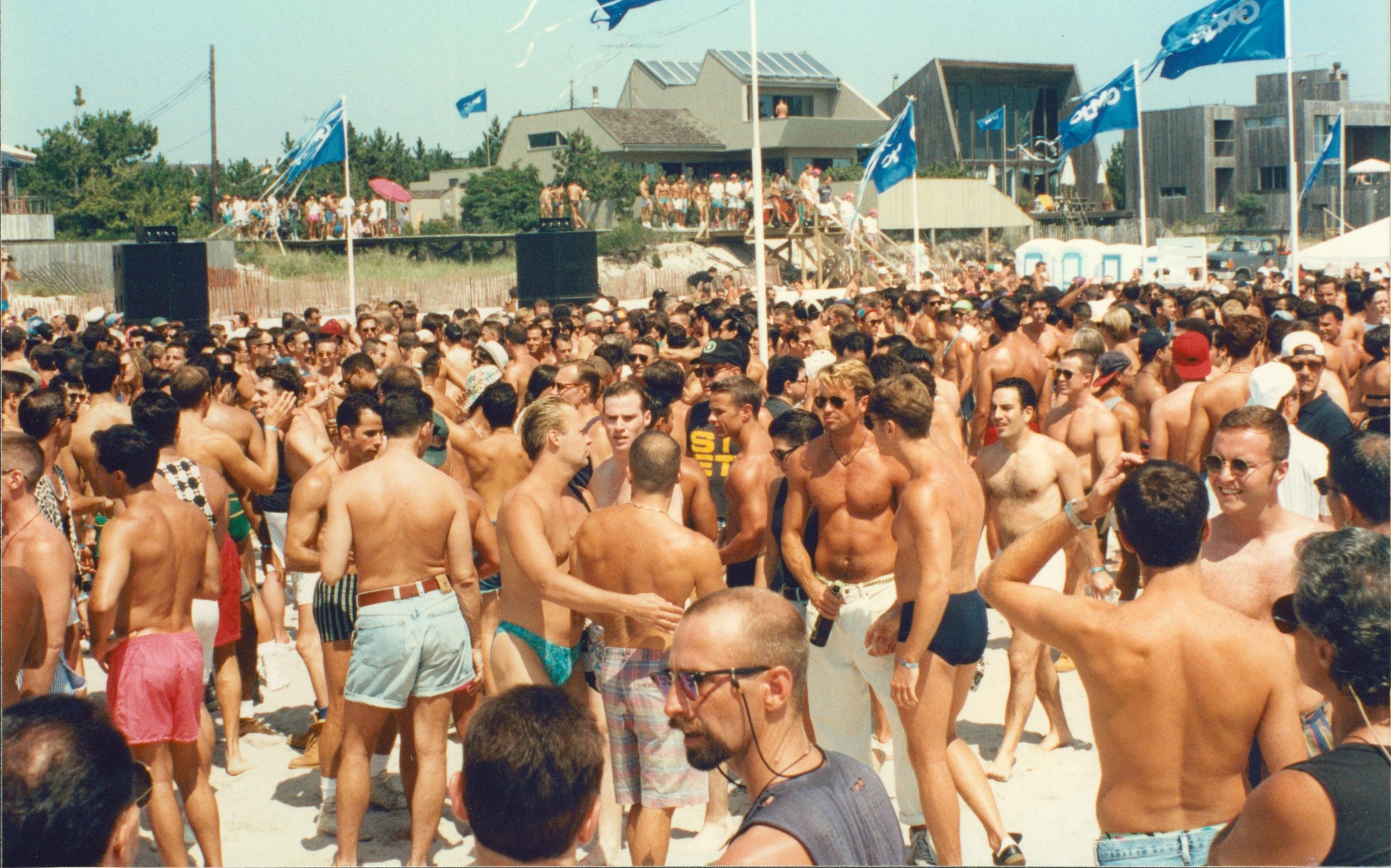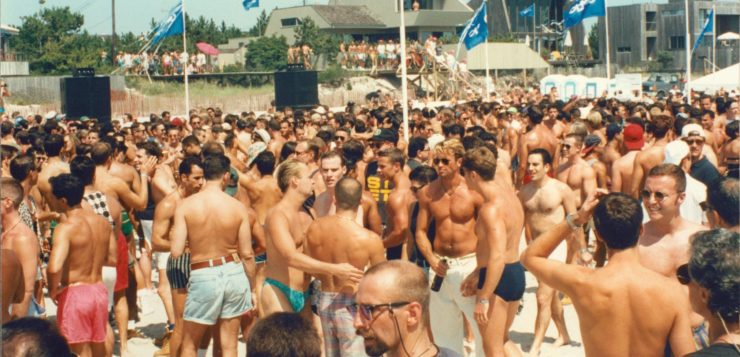 FIRE ISLAND
FIRE ISLAND
A Century in the Life of an American Paradise
by Jack Parlett
Hanover Square Press
266 Pages, $27.99
 THE POETICS OF CRUISING
THE POETICS OF CRUISING
Queer Visual Culture from Whitman to Grindr
by Jack Parlett
Univ. of Minnesota Press
233 pages, $27.
FROM THE AIR, Fire Island looks like a long, narrow sandbar keeping the Atlantic from the inner bays of south Long Island. While connected at its western end by a bridge to the state park, there is no highway, no thoroughfare of any kind, along its great length. A ferry ride of twenty to forty minutes is needed to arrive at any of the dozen or so settlements, and each community instantly presents itself as visually different and unique—which they all are, often in unexpected ways.
Jack Parlett’s Fire Island: 100 Years of a Gay Paradise presents the history in the form of literary portraits of writers and editors connected to either Cherry Grove or Fire Island Pines, the two gay communities in the center of that sunny sandbar. Parlett starts with the period 1882 to 1938 at Cherry Grove, from its beginnings through its bifurcation and near destruction by the great hurricane of 1938. Lesbian power-couple Natalia Danesi Murray and Janet Flanner (“Genêt” at The New Yorker) and Natalia’s son William (whose father was the cofounder of the William Morris Agency) are here representing the kind of casually ultra-private sophisticates who summered at the Grove, resulting in its early artsy or boho image. An anti-fascist Italian book editor, Murray helped in the democratic reconstruction of postwar Italy, building the Rizzoli media empire. Later, relocating in the U.S., she headed up Rizzoli America during its best years.
The next section, 1939 to 1969, focuses on writer Donald Wyndham and his partner Sandy Campbell, and then on W. H. Auden in Cherry Grove in the ‘40s, and on his singular relationship with Chester Kallman. Kodak photos show the poet, along with Christopher Isherwood and Stephen Spender, back together for the first time in over a decade, since their sex-filled German stay at pre-war Rügen Island. After World War II, gay and lesbian writers were all but trampling the sea-grape bushes of Cherry Grove. Edward Albee, Carson McCullers, Patricia Highsmith, et al., made the Grove an ongoing martini and scotch party. Fun and local scandal erupted. Those palmy and rather innocent years were ended by Frank O’Hara’s still not-well-explained death by sand-going beach taxi.
Oddly, the one section in that isn’t as satisfying as the others is 1969 to 1979, which the author calls the “Halcyon” years. Yes, they were, but if you go by Parlett, you might wonder why. Perhaps the problem is that, as the author himself admits early on, he believes that he would find himself physically unfit to be among all those men. (Not so.) Or perhaps it’s the authors he chooses to briefly illustrate his chapter. Edmund White and George Whitmore were never more than very occasional visitors in that period. Andrew Holleran was gone before halfway through the decade. Not one of them led what could be called very “Halcyon” lives there.
Instead, Parlett focuses on the Morning Party, a huge, public fund-raising event on the beach held for the F. I. Pines Fire Department. But those who were in the know knew that another, large, “private” Pines party a week later was the real event to be at, and also more typical, coming as it did after a decade of large, “private,” famous F. I. parties, titled “Fellini,” “Carmen Miranda,” “Egyptian,” “Star Wars,” “Peacocks,” and “Cockatoos.” This writer was picking blackberries on Midway Walk when my neighbor invited me. Guy, Duc de Rohan (“my ancestor crowned Charlemagne”) and his lover had split up so he needed a date, and this was a celebration. The lover got the adjoining house with a pool, etc. The night of the event, Gladys Knight and the Pips in silver lamé jumpsuits were helicoptered in as entertainment. The adjacent pools were boarded over to be a dance floor, and the diving boards built up to become DJ booths. The invitation read “Just Another Party.”

It’s almost impossible to convey the devastation wrought by AIDS for the Fire Island community, which had indeed been celebrating as much as possible being gay for over a decade. Back in town after weekends on F.I., my CPA, my dentist, my barber, and everyone else used to enthuse about how amazing and fabulous, how freeing and ego-boosting, Fire Island was for them that past weekend. Parlett gets the first part, but not really the second, in the fourth section, 1981–2000, titled “Plague.”
Here the focus is first on Larry Kramer, who pretty much hated everything and everyone in the Pines. Once his contemptuous book Faggots—with what Martin Duberman called its “primitive moralizing”—was published, Kramer went from someone just tolerated at the Pines to a persona non grata. Parlett does better when he shifts his focus to Vito Russo, who was a film maven extraordinaire, a lecturer on the topic for decades and author of the groundbreaking book The Celluloid Closet, the first book that did justice to the hidden and overt presence of homosexuality in films from the silent era to the time of its publication in 1981 (with a revised edition in 1987). First Russo’s partner got sick and died, and then he too was diagnosed, at which point Russo became a driving force for ACT UP, galvanizing meetings and on-site actions like the St. Patrick’s Cathedral “die-off,” which gained publicity, notoriety, and a massive membership, far beyond what Kramer had been able to achieve.
Here the author of Fire Island—like documentary film maker Jeffrey Schwartz in his 2011 film Vito—misses Russo’s element of puckishness and mischief-making that his “Sweeties”—his close friends—knew so well. For example, he showed this writer how to get into top Broadway shows and first-run films without paying, declaring: “I’m a critic. I never pay.”
The concluding section is called “a paradise” in lower-case letters, and it’s a summation of what is really the best book about Fire Island to date: its inhabitants, some of its standout personalities, and possibly what it once meant and still can mean to us all today. Few of the Cherry Grove and Pines regular “characters” are discussed at length, and perhaps that’s another book. These communities have changed, of course, but they are still there, hanging on like the sandbar itself, as hurricanes and the rising Atlantic Ocean chip away at their dunes.
A SECOND BOOK by Parlett, The Poetics of Cruising, also published this year, is about a mode of behavior that is primarily visual. This book is aimed at an entirely different audience: a scholarly one, preferably readers invested in Queer Theory. At any rate, Parlett pays constant homage to that readership, as revealed in his choice of words and phrases: “imbrication,” “programs of apprehension,” “intersectional,” “luminal perception,” and so on. I suspect this was a doctoral thesis expanded into a book.
Similar to the other book under review, in this one Parlett uses poems and poets to illustrate his theory that cruising is a valid gay literary trope. Of course, for him cruising is much more than just one person looking at another. It seems the implications of cruising go far deeper than that: “It turns snatches of remembered glances into the sensible material of art, which pertains not just to aesthetic form but to its execution as song and celebration, and apostrophizes the democratic potential of ‘manly attachment.’” Gee, and I thought it was just guys looking for a good time.
The selection of poets is interesting: Walt Whitman, Langston Hughes, Frank O’Hara, David Wojnarowicz, Eileen Myles, and ending—as has cruising itself—with Grindr. The poems chosen for dissection are always good ones, including one by Baudelaire, “À une passante,” about a chance encounter with a woman on a crowded Paris street. Not only “Queer Visual Culture” but a panoply of other related and unrelated visual cultures is brought to the fore.
Queer Theory scholars should be satisfied by Parlett’s gesture in their direction. For the rest of us, once he’s writing about the poets, he’s fully comprehensible. But the big question for the general reader may be why all this matters. When this writer traveled to Boulder, Portland, Dallas, and St. Louis in the 1970s, gay men in those towns recognized that what I was doing before meeting them was “cruising,” even though few in their space and time knew how to do so. As more men came out or semi-out, this new urban behavior became commonplace, even in small towns, and then became codified. Cruising was a behavior that paid off because it was effective at securing what was wanted: a sex date. It too possessed perils due to its sartorial accouterments. When I saw my older, heterosexual brother in jeans and flannel shirt with a red handkerchief in his left-hand back pocket, I felt I ought to warn him what that actually “meant.” He had just thought it was stylish.
The practical aspects of 1970s gay “style” in fashion, music, and a few other areas of popular culture became rapidly absorbed in the U.S. and quickly enough in Britain and Europe—usually because it was stylish, not because it signaled a particular sexual orientation. The purest example of this is when Diana Ross premiered her new disco single at the very private gay dance club Flamingo, the message being that the few hundred men were the style makers and the tastemakers who would make her song into a mega-hit.
When a show titled The Art of the Body premiered at New York’s Museum of Modern Art not long after that, with mostly nude, live, straight muscle men—Arnold Schwarzenegger, Lou Ferrigno, and others doing elaborate “body building poses”—they were taking a gay-associated cultural backwater and making it both known and culturally relevant to the general public. Soon other public expressions of gayness would follow, such as the Queer Eye for the Straight Guy series, the phenomenon of metrosexuality, RuPaul’s Drag Race, and most recently, TV commercials for “manscapers.” Like gay men for decades, now every straight man can safely shave his pubes to perfection to fit that new, ultra-soft underwear with prominent “fronts” that are virtually cloth codpieces.
Even when cruising itself became stagnant—by 1990, S/M bars were being called “stand and model” venues—gay visual, aural, and fashion culture never ended. It seems to pop up everywhere, and the art of cruising for style can now be enjoyed by everyone. When an older gay friend spotted a handsome Tumi shoulder bag on an apparently hetero young male actor/model on the New York City subway, he asked about it, and they ended up chatting about shoulder bags for ten minutes. Perhaps the advent of the metrosexual will be the subject of another doctoral thesis.
Parlett ends his chapter on Whitman by speaking about the photograph Walt approved as a frontispiece to his Leaves of Grass when it was first published in 1855. The poet himself called the shot “flamboyant”: he is standing insouciantly, hand on hip, in a carefully arranged pose. Parlett reveals that it was even touched up at the crotch. Yet when the book was reissued recently in a supposedly “historically identical edition” to that first one, the sexy frontispiece photo was gone, and the paper cover had a rather dim profile of an aged Whitman as “the good gray poet.” Even so, that original photo—along with the only acknowledged one of Arthur Rimbaud—is known to all. They are literally “iconic.”
Since Whitman, gay writers have followed Walt’s example: John Rechy’s shirtless photo at age 25 graced his books until quite recently, and he’s now in his nineties. When this writer published The Lure in 1979, the back cover photo that the agent, editor, and art director chose was not taken at a desk in my library but standing against a wall, one leg behind me. The aged owner of the stolid Delacorte Press moaned: “It looks like you’re for sale.” As Whitman knew well, sex sells, and visuals convey sex better than words.
Felice Picano’s latest novels are the duology Pursuit: A Victorian Entertainment (2021) and Pursued: Lillian’s Story (2022).






